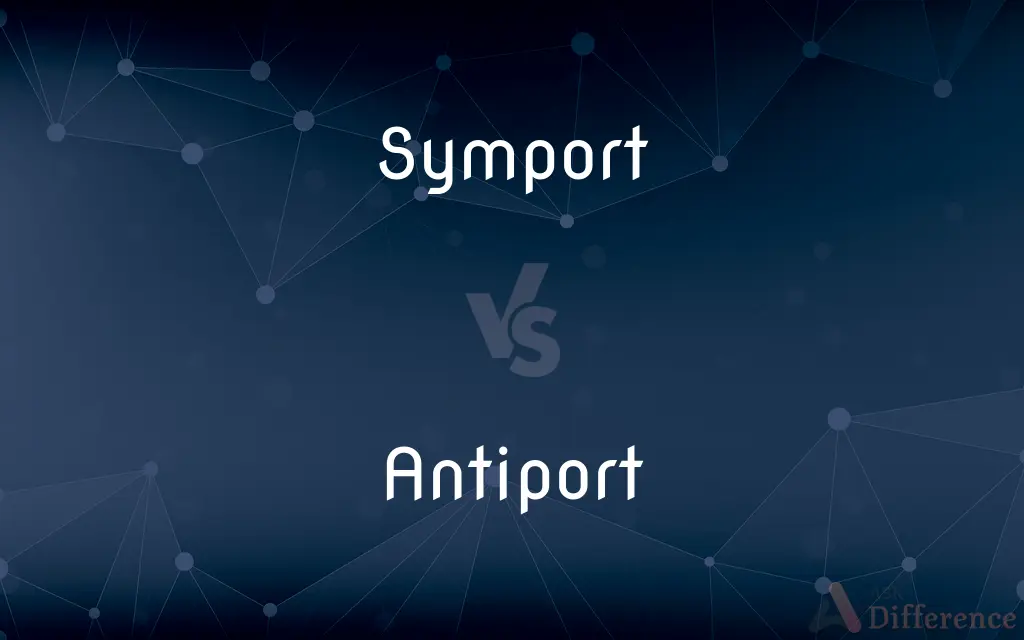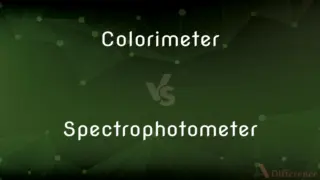Symport vs. Antiport — What's the Difference?
By Tayyaba Rehman & Fiza Rafique — Updated on April 16, 2024
Symport involves the simultaneous transport of two substances in the same direction across a membrane, while antiport moves two substances in opposite directions.

Difference Between Symport and Antiport
Table of Contents
ADVERTISEMENT
Key Differences
Symporters function by moving two molecules or ions through a cell membrane in the same direction, utilizing the gradient of one to transport the other. In contrast, antiporters also transport two species but in opposite directions, exchanging one ion or molecule for another across the membrane.
Symport systems often utilize the energy from the movement of one molecule down its gradient to drive the transport of another molecule against its gradient. Whereas, antiport systems use the energy of one ion moving down its concentration gradient to facilitate the movement of another ion against its concentration gradient.
Examples of symport include the glucose-Na+ symporter in intestinal cells that helps in glucose absorption by cells. On the other hand, the Na+/H+ antiporter in various cells helps maintain pH balance by exchanging sodium for hydrogen ions.
Symport is crucial in processes where cells need to absorb nutrients against a concentration gradient, leveraging energy from another gradient. Conversely, antiport is essential in waste elimination and ion regulation, balancing ions like sodium and potassium across cellular membranes.
Regulation mechanisms in symporters are often influenced by the concentration gradients of both transported substances, dictating the rate and direction of transport. In contrast, antiporters are regulated by the gradients of exchanged substances, which can also trigger feedback mechanisms to control cellular homeostasis.
ADVERTISEMENT
Comparison Chart
Direction of Transport
Moves two substances in the same direction.
Moves two substances in opposite directions.
Energy Utilization
Uses the downhill movement of one substance to power the uphill transport of another.
Uses the downhill movement of one ion to exchange another against its gradient.
Example
Glucose-Na+ symporter in intestinal cells.
Na+/H+ antiporter in renal and other cells.
Biological Role
Facilitates nutrient absorption and ion co-transport.
Regulates ion balance and expels waste.
Regulation
Influenced by the gradients of transported substances.
Governed by the need to balance internal ionic conditions.
Compare with Definitions
Symport
A transport mechanism where two molecules are moved together across a membrane in the same direction.
The Na+-glucose symporter in the small intestine aids in glucose absorption.
Antiport
A mechanism that exchanges two ions or molecules in opposite directions across a membrane.
The Na+/Ca2+ exchanger is a key antiport system in cardiac muscle cells.
Symport
Involves the co-transport of ions or other solutes, linking their transport to a common carrier.
The symport process efficiently reabsorbs valuable ions and nutrients.
Antiport
Operates typically to maintain homeostasis within cellular environments.
Antiport systems regulate pH by exchanging ions across cell membranes.
Symport
Integral in processes where nutrient uptake is against a solute's concentration gradient.
Symport systems are vital for absorbing amino acids in the gut.
Antiport
Often involves the regulation of ions like sodium and potassium.
The Na+/K+ pump is an essential antiport mechanism for cell function.
Symport
Typically found in cell membranes where energy conservation is critical.
Symport mechanisms are essential in kidney function.
Antiport
Utilizes the gradient of one molecule to facilitate the transport of another.
Cellular energy management often relies on antiport systems.
Symport
Driven by electrochemical gradients, often using ions like sodium.
Sodium ions drive symport processes in many biological systems.
Antiport
Critical in processes such as waste elimination and pH balance.
Antiporters remove excess hydrogen ions from cells.
Symport
The transportation, through a membrane, of molecules of more than one substance at the same time.
Antiport
(cytology) A structure in a cell membrane that simultaneously transports different molecules or ions through the membrane in opposite directions
Symport
To simultaneously transport molecules of different substances through a membrane.
Antiport
To simultaneously transport different molecules or ions through a cell membrane in opposite directions
Common Curiosities
Can you give an example of an antiporter?
An example of an antiporter is the Na+/H+ exchanger, which helps in regulating pH inside cells by exchanging sodium for hydrogen ions.
What is antiport?
Antiport involves the simultaneous transport of two substances in opposite directions across a cell membrane.
Can you give an example of a symporter?
An example of a symporter is the glucose-Na+ symporter, which helps in the absorption of glucose in the intestines.
How do symport and antiport differ in energy use?
Symport uses the energy from one substance moving down its gradient to transport another substance up its gradient, while antiport uses similar energy dynamics but transports substances in opposite directions.
What role do antiporters play in cell physiology?
Antiporters are vital for maintaining cellular homeostasis, regulating ion concentrations, and balancing pH levels by efficiently exchanging ions across the cell membrane.
Are symport and antiport forms of active or passive transport?
Both symport and antiport are generally considered forms of active transport because they often involve the movement of at least one substance against its concentration gradient, typically driven by the energy stored in ionic gradients.
What is symport?
Symport is a type of active transport where two substances move in the same direction across a membrane, typically driven by ion gradients.
How are symporters and antiporters regulated?
These transport mechanisms are regulated by factors such as substrate availability, ion concentration gradients, and cellular energy levels, ensuring efficient transport according to cellular needs.
How does the sodium-potassium pump relate to antiport mechanisms?
The sodium-potassium pump is a type of antiporter that exchanges sodium ions for potassium ions across the plasma membrane, crucial for cellular functions and maintaining voltage gradients.
Why are symporters important in cellular functions?
Symporters are crucial for transporting essential nutrients like glucose and amino acids into cells, especially when these substances need to be moved against their concentration gradients.
How does the directionality of symport and antiport affect cellular metabolism?
Symporters facilitate the accumulation of necessary substances within the cell, supporting metabolic processes, while antiporters help remove waste or excess ions, preventing metabolic imbalances.
Can symporters and antiporters work independently of ATP?
Yes, many symporters and antiporters operate independently of direct ATP hydrolysis. They typically utilize the energy from the electrochemical gradients of ions like sodium, which may have been originally established using ATP-driven pumps.
What distinguishes symporters from uniporters?
While symporters move two different molecules in the same direction, uniporters transport only one kind of molecule, and do not necessarily require the movement of a second molecule.
What are some clinical implications of malfunctioning symporters and antiporters?
Malfunctions in these transport mechanisms can lead to various diseases, such as hypertension from disrupted sodium-potassium balance, and diabetes from impaired glucose transport.
Share Your Discovery

Previous Comparison
Colorimeter vs. Spectrophotometer
Next Comparison
Lisboa vs. LisbonAuthor Spotlight
Written by
Tayyaba RehmanTayyaba Rehman is a distinguished writer, currently serving as a primary contributor to askdifference.com. As a researcher in semantics and etymology, Tayyaba's passion for the complexity of languages and their distinctions has found a perfect home on the platform. Tayyaba delves into the intricacies of language, distinguishing between commonly confused words and phrases, thereby providing clarity for readers worldwide.
Co-written by
Fiza RafiqueFiza Rafique is a skilled content writer at AskDifference.com, where she meticulously refines and enhances written pieces. Drawing from her vast editorial expertise, Fiza ensures clarity, accuracy, and precision in every article. Passionate about language, she continually seeks to elevate the quality of content for readers worldwide.













































